Shooting range
Outdoor shooting ranges are typically found away from populated areas due to concerns of safety, noise pollution and soil contamination.Indoor shooting ranges are usually constructed as standalone structures, though they may be housed in larger buildings in isolated areas such as the basement.The basic components of most indoor ranges consist of firing lines/lanes, targets and a bullet trap/"backstop" (which prevents stray shots and overpenetrations).Design considerations may vary depending on planned use but they all must address the basic requirements for operating the range safely, and that is provide ballistic protection, safety controls, proper ventilation, acoustic isolation and appropriate lighting.Floors are constructed from dense reinforced concrete with a smooth surface finish and are usually slanted slightly from up range (shooter positions) toward the backstops downrange to allow for better maintenance and cleaning.Indoor range roofs are constructed from steel joists or precast concrete panels with a smooth flat surface that will redirect misfired bullets, facilitate maintenance, and prevent lead buildup.Roof baffles are installed at a 25–30 degree angle to protect ceilings, lighting fixtures, ventilation ducts, and any other unprotected element from stray bullets.Deflectors are similar to baffles, but are not usually covered with plywood; they can be installed either vertically or horizontally and are used to redirect stray bullets from unprotected fixtures and elements inside the firing range such as doors, windows, and ventilation registers.Shooting booths are made of partitions or panels which can be acoustically treated to reduce the unpleasant effects of noise on surrounding bystanders.Targets for indoor ranges are usually a paper sheet or piece of corrugated cardboard with a printed image, either a bullseye or a silhouette.Suitable ranges can be set up in sports halls or function rooms, using simple wooden backers, pellet catchers or lightweight ballistic curtains to protect the wall behind.Although safe handling practices for lead pellets must be followed, the lack of combustion gases negates the need for the high-performance ventilation systems required on conventional indoor ranges.[7] Outdoor ranges for ISSF and Olympic shooting events often have heavily sheltered firing points to protect athletes, spectators and media from inclement weather as well as housing the sophisticated electronic target systems.Several studies of outdoor ranges have shown that prolonged exposure to lead and noise can cause health problems, particularly among employees and instructors.Consequently, operators of outdoor ranges might consider adding sound transmission barriers, absorptive materials, and natural vegetation to lessen noise emission.Outdoor military range firing points are not usually covered and may have other configurations, e.g., sloping, a gravel base or hole in the ground.[13] The firing point cover can be as simple as a tent, to a frame with only a roof (to keep off rain or sunshine) to a substantial building with appropriate apertures to shoot through.Civilian targets are usually made of paper or a plastic coreflute, sometimes with a canvas or hessian back on the larger long-range types.This allows shooters to improve their skills by quickly being able to compare their aiming point and where the actual bullet impacted the target.Other target types include a metal plate that is knocked over by the projectile such as in the air rifle sport of field target or handgun discipline of IPSC, and stationary metal plates of scaled animal outlines on which bullet strikes mark as well as those that mark the paint which is painted over again after scoring.To estimate the wind speed in mph, the angle in degrees between the bottom of the flag to the flagpole at the mid-range position between the shooter and the target is divided by 4.Employees and users are exposed to lead dust from bullets or cartridge primers, which can be inhaled or can settle on skin or clothing.The air velocity down the range is determined by the exhaust flow rate, but it has no bearing on the airflow pattern at the firing line.To demonstrate proper exhaust system function, indicators (static or velocity pressure) for flow monitoring are a good idea.Airflow at the shooting line can be unstable if it is not uniformly dispersed, allowing lead and other pollutants to be brought back into the shooter's breathing region.In practical shooting sports, a Safety Area is a bay where shooters can handle unloaded firearms without the supervision of a range officer.The phrase "safety area" is generic and can have different meanings in other shooting sport disciplines, or defined in local range standing orders.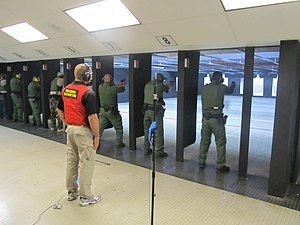



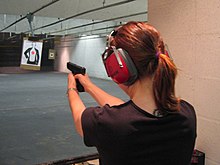


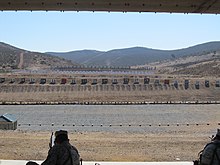

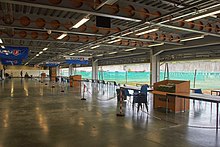
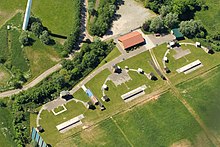






Security area procedures chart.
Shooting Range (film)Shooting Range (video game)Rifle Range, Queenslandfirearmcompetitionsmilitarylaw enforcementsporting clubssupervisoryUnited Statessafetyhandgunslong gunsOlympic disciplinesskeet shooting10 m air pistolcalibersriflesfully automatic firearmstoy gunsairgunsBB gunsairsoft gunslight gunswater gunsamusement parksarcadescarnivalsfairgroundsentertainmentprizingsouvenirstrophiesshelteringnoise pollutionsoil contaminationbasementtargetsbullet trapstray shotsoverpenetrationspoured concreteprecast concretemasonry blocksreinforced concretebullet trapsprojectileunpleasant effects of noisetarget objectelectronic scoring systemsbullseyesilhouetteventilationInterShootPlaue Castlelonger-distance shootingsandbag.50 caliberBritish Armed ForcesOlympic shootingfield targetNSRA'sBisley Camp.22 Long Rifle50 m Riflecarnival games300 m Standard Riflemetallic silhouettebenchrest shootingclay pigeon shootingarchersElectronic scoring targetsRange safetyconcealed carrylead poisoningsound pressure levelearplugsearmuffsNational Institute for Occupational Safety and HealthNational Academy of SciencesUnited States Department of Defensepractical shootingPPC 1500Steel Challengeholsterdry firedummy roundsShooting ranges in SwitzerlandShooting ranges in the United StatesISSF shooting eventsSchützenvereinShooting sportsSport venueKill houseUnited States Department of the Army